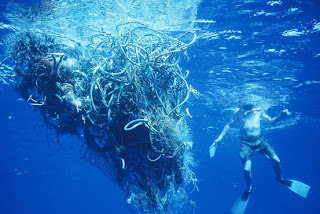
As I mentioned in earlier posts, Punta Allen Sian Kaán is one of my most favorite places in the world. Punta Allen is located in the Mexican state of Quintana Roo and is the largest town in the Sian Kaán Biosphere Reserve, a program established to promote an interdisciplinary approach to research, training, and communications in ecosystem conservation. Although I only spent a short amount of time in this beautiful place, it was very clear that the residents of this town were waging a relentless war against trash (particularly plastic) that is washing up on their practically untouched beaches. We stayed in an awesome house called Serenidad Shardon and where the owner kindly lent us anything we needed in return for a garbage bag full of trash we collected off the beach. Of course, we were more than happy to do this, but while picking up thoes never ending bits and peices of trash, the reality of the situation became more and more heartbreaking. It made a huge impact on me, and hopefully this blog will make an impact on you. I was able to get in touch with some residents from Punta Allen who were kind enough to point me in the direction of the following report. I hope that this will give you a glimps of some of the efforts being made to try and reduce this unfortunate pollution problem.
Punta Allen Green Project (PAVER) was born as a joint initiative between some mothers of primary school Punta Allen. Subsequently, other community members joined this project.
Project Scope PAVER
Whereas:
i) Punta Allen is located in a Biosphere Reserve, where the use of resources should be sustainable without compromising other forms of life;
ii) Punta Allen has a small population (about 500 inhabitants)
iii) The majority of families, restaurants, cooperatives and shops. do not separate their waste;
iv) However, there are people willing to have a waste separation program;
v) Since there have been initiatives of waste separation and cleaning of Punta Allen
vi) Punta Allen already has a storage facility;
vii) The smaller a population is, the speed and ease their awareness and implementation of initiatives is another;
PAVER Project Inauguration
PAVER Project was inaugurated on Friday, April 23, 2010, and also celebrating Earth Day. The day began with a video presentation "Environmental Heroes" (performed by volunteers from GVI (click HERE to watch the video)) in which he explained in an entertaining, how and what can be separated. The day passed with a beach cleanup and a Punta Allen, a carnival (where the maximum was reduced waste production), then, while the volleyball tournament and passed ball foot, the children had to separate their waste in their respective boats, the day concluded with a presentation on the project and the separation of garbage as well as the delivery of examinations. All children received a badge of "environmental police" and the winners (boy and girl having collected the highest amount of waste and good separation of them) were also the costumes of "environmental heroes", built by reusing materials.
PAVER Project Objectives
To date there have been small meetings and, finally succeeded in forming a committee composed of a president, vice president, treasury, secretary, representatives of each cooperative and representatives from each school.
In general, PAVER Project has several objectives that are interlinked to each other:
i) Raise awareness and educate the people of Punta Allen on the problem of garbage
ii) Have a program of separation of solid waste in this community;
iii) Acquisition of resources through the sale of waste;
iv) Maintenance of storage facility;
v) That in the near future the project to sustain itself;
vi) Make Punta Allen an example to follow.
In a timely manner PAVER Project aims to start with small initiatives and go, slowly, toward greater. In this way it is intended, initially:
i) Organize regular lectures and workshops for different groups (restaurants, cooperatives, schools, families);
ii) Conduct, with a van, weekly collections of previously separate waste at home;
iii) Conduct regular cleaning of beaches and the people;
iv) Maintain proper storage facility;
v) continuously educate the children, helping them to properly separate their waste in schools (and homes if possible);
vi) Make compost organic waste from restaurants;
vii) Other initiatives may be increased in the course of the project.
The Riviera Maya tends to population growth and tourism, which also inevitably involves increased production of waste. Despite the tourism, Punta Allen is still isolated from the massive growth and, considering the above points (in the context of the Project), the link between the community of Punta Allen to be maintained and strengthened. These two key "ingredients": i) support of sponsors and ii) the pro-activity of the people of Punta Allen are the ones that allow "season" with the progress of the Project Quality PAVER.












